Pesticide Usage in Scotland: Protected Edible Crops 2015 - Summary Report
Report on a survey of pesticide use on protected edible crops in Scotland.
This document is part of a collection
Appendix 6 - Integrated pest management
It is a requirement of the EU Sustainable use of Pesticides Directive (2009/128/ EC) (6) that member states should promote low pesticide input pest management, in particular Integrated Pest Management ( IPM).
The Directive defines IPM as follows "'integrated pest management' means careful consideration of all available plant protection methods and subsequent integration of appropriate measures that discourage the development of populations of harmful organisms and keep the use of plant protection products and other forms of intervention to levels that are economically and ecologically justified and reduce or minimise risks to human health and the environment. 'Integrated pest management' emphasises the growth of a healthy crop with the least possible disruption to agro-ecosystems and encourages natural pest control mechanisms."
Therefore, for the first time in this series of surveys, additional data collection was conducted in relation to grower adoption of Integrated Pest Management ( IPM) measures. The term 'pest' is used to denote diseases, weeds and pests. This data collection was designed to inform the Scottish Government about the current adoption of IPM in the main crop sectors and will be collected for all subsequent surveys to allow analysis of changes in uptake over time.
All growers were asked a series of questions about the IPM activities that they were implementing for their protected edible crop production. Unlike the other statistics in this report, the figures reported in this section are not raised ( i.e. are not national estimates) but represent only the responses of those surveyed.
In total IPM data was collected from 15 holdings, representing 87 per cent of the sampled crop area and 15 per cent of the total crop area. Of these growers, 13 per cent had completed an IPM plan for their crops ( Figure 10).
Figure 10 Proportion of respondents with an IPM Plan
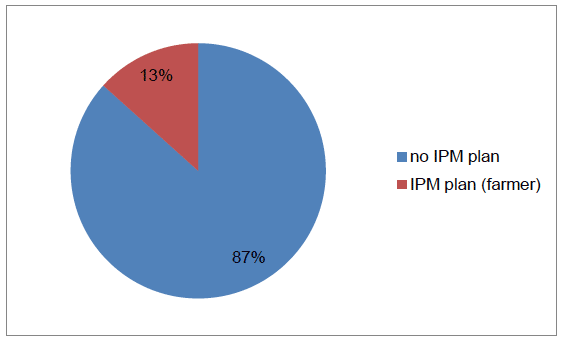
Growers were asked about their IPM activities in relation to three categories; risk management, pest monitoring and pest control. Information was collected about all activities growers conducted in relation to each category.
Risk management
IPM programs aim to prevent or reduce the risk of pests becoming a threat by minimising the risk of damage occurring that will require subsequent control. Table 18 presents an overview of the risk management measures adopted by the growers surveyed.
Two thirds of growers used crop rotation to manage the risk of pest damage. Rotation is a basic principle of farming breaking the link between pathogen and host and reducing pest population build-up. It can also improve soil fertility and structure consequently increasing the vigour of subsequent crops.
A similar proportion (60 per cent) of growers tested their soils in order to tailor inputs to improve crop performance. Almost half of growers tested soil nutrient levels with lower proportions testing for disease, pH and insect pests ( Figure 11). By pre-emptively testing for nutritional and pest status farmers' can make informed decisions about inputs required and crop choice for that field.
Almost three quarters of growers managed their seed bed agronomy to reduce risk. All increased organic matter to improve soil quality while a smaller proportion implemented other measures such as using a stale seed bed, considering pest management when planning irrigation, adoption of no till systems and use of seaweed to control pests ( Figure 12).
Almost two thirds of growers amended cultivation methods at sowing. Just over half chose to use pest free growing media such as peat, coir and hydroponic systems. Other growers varied sowing rates and dates to mitigate for potential pest damage ( Figure 13).
Almost two thirds of the growers surveyed also considered risk management when selecting seeds and/or varieties. A third selected pest resistant varieties to reduce damage. Some growers (13 per cent) also confirmed that they chose to adopt varietal diversification (using a range of different varieties) to increase overall resistance to pests and environmental stresses. The same percentage used certified seed which has been tested to ensure it meets quality standards. A fifth of growers used seed treatments to protect seedlings at crop emergence. A fifth also reported other activities such as avoiding growing crops which had been affected by insect and disease damage in the past and choosing to grow heritage varieties ( Figure 14).
Almost half of respondents sowed catch or cover crops as part of their crop production cycle. These crops were cultivated to improve soil quality, suppress weeds and provide habitats for beneficial insects ( Figure 15).
Finally, 60 per cent of the growers sampled adopted techniques to protect or enhance populations of beneficial insects ( Table 18). A third planted wild flower strips, 20 per cent planted pollen sources and 13 per cent maintained uncultivated strips. Other strategies included creation of ponds and placing bee hives, hedging and trees beside polytunnels. In addition a small number of respondents used push-pull strategies to manage pests by using attractive trap crops and repellent treatments on the main crop ( Figure 16)
Table 18 Summary of responses to risk management questions
| Risk management activity | Percentage yes response |
|---|---|
| Crop rotation | 67 |
| Soil testing | 60 |
| Cultivation of seed bed | 73 |
| Cultivations at sowing | 67 |
| Varietal or seed choice | 60 |
| Catch and cover cropping | 47 |
| Protection or enhancement of beneficial organism populations | 60 |
Figure 11 Focus of soil testing (percentage of respondents)

Note: other was testing for pH
Figure 12 Seed bed cultivations adopted to reduce pest risk (percentage of respondents)
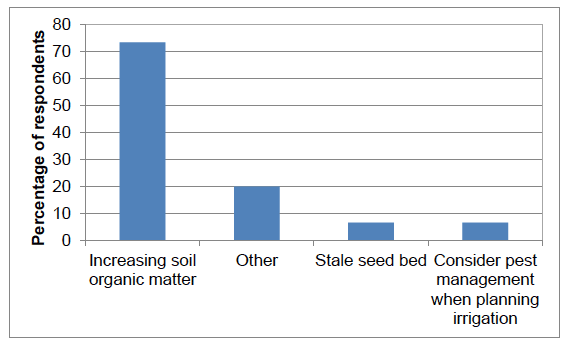
Note: the other category includes no tillage systems and the use of seaweed to control pests
Figure 13 Sowing cultivations adopted to reduce pest risk (percentage of respondents)
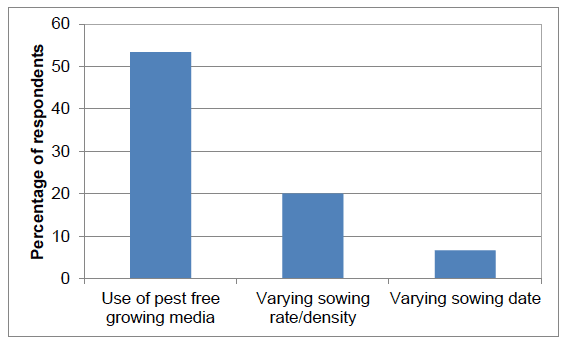
Figure 14 Variety and seed choice to reduce pest risk (percentage of respondents)
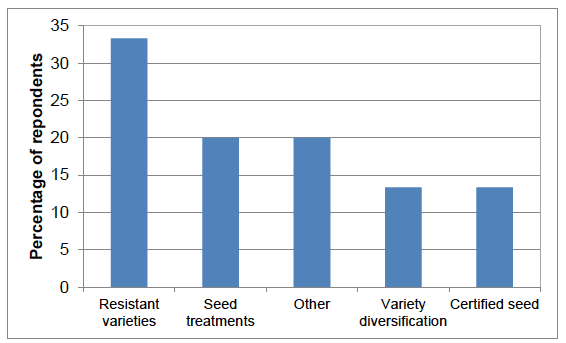
Note: the other category included avoiding growing certain crops and growing hardy or heritage varieties.
Figure 15 Catch and cover cropping (percentage of respondents)
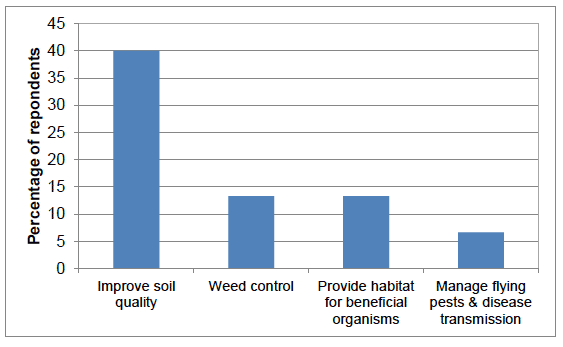
Figure 16 Protection or enhancement of beneficial organism populations (percentage of respondents)
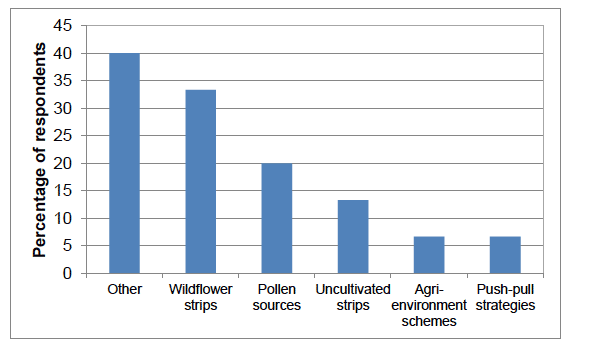
Note: the other category included the use of ponds, bee hives and planting of hedges and trees beside poly tunnels.
Pest monitoring
In IPM pests are monitored to determine whether control is economically justified and to be able to effectively target control options. IPM programs aim to monitor and identify pests, so that appropriate control decisions can be made in conjunction with action thresholds. Table 19 presents an overview of the pest monitoring measures adopted by the growers surveyed.
Sixty seven per cent of growers regularly monitored crop growth stages and 73 per cent monitored and identified pests on their crops. Pest monitoring was by conducted primarily by self-inspection (73 per cent) but also by trapping (20 per cent) and by use of agronomists ( Figure 17). In addition, some growers (13 per cent) used specialist diagnostic testing for pests that are more problematic to identify or monitor.
Table 19 Summary of responses to pest monitoring questions
| Pest monitoring activity | Percentage yes response |
|---|---|
| Setting action thresholds for crops | 13 |
| Monitor and identify pests | 73 |
| Use of specialist diagnostics | 13 |
| Regular monitoring of crop growth stage | 67 |
Figure 17 Methods of monitoring and identifying pests (Percentage of respondents)
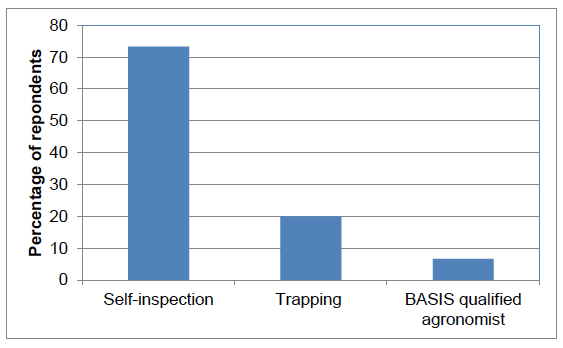
Pest control
If monitoring, identification, and action thresholds indicate that pest control is required, and preventive methods are no longer effective or available, IPM programs evaluate the best control method in relation to effectiveness and risk. Control programmes incorporate non-chemical methods alongside, or instead of, chemical control. Use of chemical pest control should be as targeted as possible and the risk of resistance development should be minimised. The effectiveness of the control programme should be reviewed regularly to gauge success and improve their regime as necessary. Table 20 presents an overview of the pest control measures adopted by the growers surveyed.
The majority of growers (80 per cent) used non-chemical control in partnership or instead of chemical control. A range of control methods were adopted, including use of biological control and physical/mechanical control measures ( Figure 18).
Forty per cent of growers stated that they targeted their pesticide applications using monitoring data ( Table 20). It should be noted that only 40 per cent of the sample used any pesticides excluding the use of biologicals or disinfectants. In addition, pesticide use was minimised using a range of techniques such as spot treatments (40 per cent) and weed wiping (7 per cent). Thirteen per cent of respondents also stated that they reduced the dosage or frequency of applications where possible.
In addition, 27 per cent of growers stated that they followed anti-resistance strategies. These included 20 per cent minimising the number of applications and seven per cent using pesticides with multiple modes of action.
The majority of growers (80 per cent) stated that they monitored the success of their crop protection measures. Almost three quarters self-inspected control measure success and seven per cent conducted a seasonal review of pest control practice and investigated causes of poor efficacy ( Figure 19).
Table 20 Summary of responses to pest control questions
| Pest control activity | Percentage yes response |
|---|---|
| Non-chemical control used in partnership or instead of chemical control | 80 |
| Targeted pesticide application (using monitoring data) | 40 |
| Follow anti-resistance strategies | 27 |
| Monitor success of crop protection measures | 80 |
Figure 18 Types of non-chemical control used (percentage of respondents)
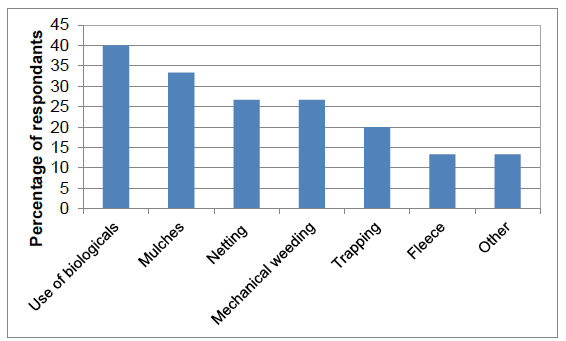
Note biologicals include the use of biological control agents and biopesticides. Other includes removing pests such as slugs by hand.
Figure 19 Methods for monitoring success of crop protection measures (percentage of respondents)
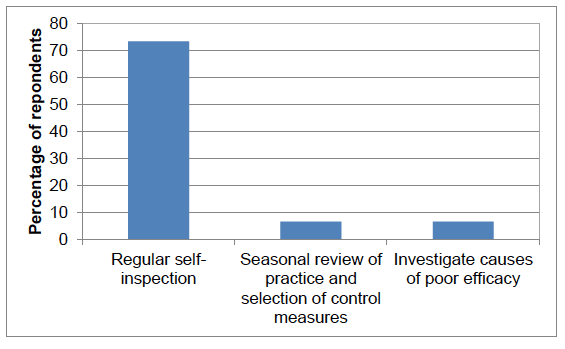
Contact
There is a problem
Thanks for your feedback